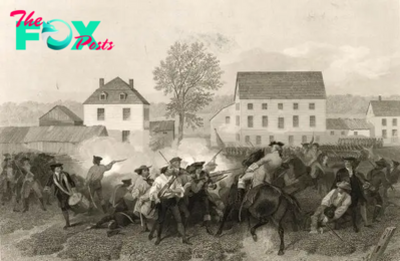History
The Story of Killers of the Flower Moon Isn’t Over
“These things actually happened.”
A simple but important reminder from actor Leonardo DiCaprio about the painful chapter of history depicted in Killers of the Flower Moon, the Martin Scorsese film he co-stars in alongside Lily Gladstone. The movie sheds light on the "reign of terror" that a group of white people inflicted upon the Osage Nation in Oklahoma in the 1920s in order to profit from oil on Osage tribal lands.
Although it has generated a historic Golden Globe win for Gladstone, as the first Native American women to win best actress in a dramatic film, and plenty of Oscars buzz, some critics have complained the film is too long. Yet, its run-time of nearly 3.5 hours is not nearly long enough to convey how true stories of racism and greed have stretched well beyond the Osage people and into the present to impact the lives of Native Americans today.
Many movie-goers will think the events depicted in Killers of the Flower Moon were isolated incidents of theft and injustice. This perspective is wrong. The villains portrayed in the film were just individuals whose actions reflected U.S. national policy. A series of laws, from the Louisiana Purchase and the Indian Removal Act, to the Homestead and Dawes Acts, authorized the violent occupation, expropriation, and subdivision of Native territories and families.
Take Illinois, for example. In the spring of 1829, while Sauk families were away from their summer villages for hunting season in the western part of the state, white settlers moved in and “enclosed nearly all the Sac Indians [sic] cornfields.” The Sauk leader Black Hawk received reports “that three families of whites had arrived at our village, and destroyed some of our lodges, and were making fences and dividing our cornfields for their own use.” Upon his return, he wrote, “I went to my lodge, and saw a family occupying it.” The military followed this first wave of white occupation. After years of war against the Sauk people, they were forcibly removed from Illinois.
Read More: How Killers of the Flower Moon Captures the True Story of the Osage Murders
By the end of this coordinated campaign of uncompensated takings across what because the United States, Native Americans experienced a nearly 99% reduction of the land they had called home for millennia. The areas where they now live are more susceptible to environmental and climate risks and less abundant in mineral resources than the territory on which they historically resided. The parceling and privatization of Native American reservations and the mass slaughter of the bison by U.S. forces in the 19th century are both associated with decreased per capita income among Native Americans in the 21st century.
U.S. laws and campaigns enabled more than just the theft of land. The Civilization Fund Act of 1819 was aimed at destroying Native American cultures. The Act forcibly removed Native American children from their families and placed them in boarding schools across the country. By 1925, over 80% of Native school-age children were in boarding schools. In keeping with the philosophy of assimilation in service of “extinction,” children in these schools were forbidden to speak their native language, wear traditional clothes (which were replaced by uniforms), or perform tribal practices (replaced by Christian practices). School officials cut students’ hair, confiscated ritual items, replaced students’ given names with English-language names, and discouraged, if not forbade, contact with family and community members.
The impacts of these abuses reverberate across generations. Research shows that the children of boarding school attendees suffer greater mental Health and substance abuse challenges compared to children whose parents were not taken from their families. Similar negative intergenerational effects resulted from The Indian Relocation Act of 1956, which moved Native families from reservations to large cities. In other words, the land, wealth, and cultural expropriation that Native Americans have experienced is more than just a story from our nation’s past—it is still harming the economic and social well-being of Native Americans today.
Read More: The History of Native American Boarding Schools Is Even More Complicated than a New Report Reveals
The story of the Osage illustrates how historical events contribute to present-day inequalities. A single claim to Osage oil and mineral reserves has generated roughly $4 million in profit over the past century. But rather than going fully to Osage citizens, a quarter of the rights to oil profits today are held by non-Osage members due to the decades of violence and deceit portrayed in Killers of the Flower Moon. As a result, in a place that might have otherwise been a model of Native American financial wealth and well-being, 16% of Native American residents of Osage County have incomes below the poverty line, compared with 12% of their white counterparts. Nationally, the disparity is even more stark. The Native American poverty rate is roughly three times the white poverty rate.
Just as the Osage Nation continues to reel from the lasting effects of systematic cruelty, so too do Native American communities across our nation. A recent National Academies report on intergenerational poverty reveals a stark reality: 46% of Native American children who lived in low-income households grew up to live in low-income households as adults, compared to 29% of low-income white children. In addition to the historical factors, Native Americans encounter persistent barriers to accessing quality health care and schools. They have greater exposure to crime, violence, and harm from the criminal justice system. They experience more housing insecurity and exposure to toxins. And, as a result, they have lower family incomes from one generation to the next.

Fully addressing racial disparities in intergenerational poverty will require policies and interventions that have particularly strong benefits for Native American families and children. These solutions include everything from broad policies like increasing K–12 school funding, reducing pollution, funding nutrition programs, and expanding the Earned Income Tax Credit, to more targeted reforms such as reducing harsh school discipline, reducing juvenile incarceration, and increasing the number of Native American teachers. Any strategies and efforts to increase upward mobility across generations should prioritize Native sovereignty and control.
The creators behind Killers of the Flower Moon deserve credit for using their platforms and star power to tell the truth about what happened to the Osage Nation in the 1920s. But when the movie’s end credits roll and the curtain draws, remember that the story isn’t over.
Mary Pattillo is the Harold Washington Professor of Sociology and Black Studies at Northwestern University. She also serves as Chair of the Department of Black Studies.
Made by History takes readers beyond the headlines with articles written and edited by professional historians. Learn more about Made by History at TIME here. Opinions expressed do not necessarily reflect the views of TIME editors.
-

 History15h ago
History15h agoThe U.S. Must Win the Quantum Computing Race. History Shows How to Do It
-

 History1d ago
History1d agoHow Hitler Used Democracy to Take Power
-

 History2d ago
History2d agoPuerto Rico Is Voting for Its Future
-

 History2d ago
History2d agoRegulation of Pelvic Exams Is Long Overdue
-

 History4d ago
History4d agoWhat Was Revealed When British Officials Calculated How Much a Colonial Subject’s Life Was Worth
-

 History6d ago
History6d agoThe Truth About the Past That ‘Tradwives’ Want to Revive
-

 History1w ago
History1w agoHow the NBA Learned to Embrace Activism
-

 History1w ago
History1w agoThe Last Witness to the Shot Heard Round the World



















